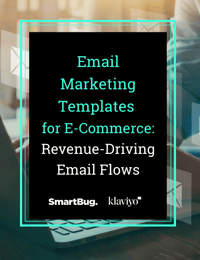
In the fast-paced world of business, acquiring new customers is crucial—but retaining existing ones is equally important. The post-purchase moment is pivotal in the buyer’s journey. It can determine whether you’ll be a one-time buy or become a trusted go-to brand. A successful email marketing strategy includes post-purchase emails that drive engagement, revenue, loyalty, and, ultimately, customer retention.
Many marketers are looking for ways to meet business goals with an efficient and cost-effective marketing strategy—and those savvy marketers know it costs more to find new customers than to retain existing ones. This article will explain how you can maximize your marketing efforts and fuel customer retention with post-purchase emails.
What Are Customer Retention Emails?
Marketers send customer retention emails to existing customers to strengthen relationships, encourage product use, and drive repeat purchases. They are cost-effective, increase brand loyalty, reduce customer churn, and generate more revenue for your business.
Customer retention emails come in various forms, but they all aim to remind customers of recent interactions with your brand and offer value. These emails go beyond transactional updates and promotions, focusing on building a connection with customers over time. They can include personalized content, exclusive offers, and information that adds value to the customer experience.
Transactional emails are just one type of customer retention email. Other examples include thank you emails, review requests, cross-sell and up-sell messages, and replenishment emails.
How Do Post-Purchase Emails Fuel Customer Retention?
The advantages of implementing post-purchase emails in your marketing strategy make it a no-brainer! A well-crafted customer retention email strategy is a powerful tool, offering a multitude of benefits that extend beyond basic retention.
Staying connected with your customers throughout the customer journey helps maintain their loyalty and trust. It also increases their perception of your business’s value and encourages active engagement with your brand. When done correctly, customer retention emails are not only effective but also cost-efficient. Here are just a few benefits of a good customer retention email strategy.
Loyalty and Trust
A small- or medium-sized e-commerce business doesn’t automatically have the level of trust a large well-known brand does. Customer retention emails provide a valuable way to communicate and give customers peace of mind.
Retention emails also ensure that your brand remains memorable by consistently communicating throughout the customer experience. This helps to establish a strong bond between your brand and customers. Engaging with customers post-purchase creates a sense of loyalty and reduces the likelihood that they’ll switch to competitors.
Increased Customer Lifetime Value (CLV)
Using emails to inform customers about your brand and products can boost loyalty and increase sales. Customer retention emails are important for making the most money from each customer during their time with your brand.
Increased Brand Engagement
You can automate and trigger customer retention emails to be sent to recipients based on their actions. Recipients tend to open these automated, personalized emails more than obviously mass-sent emails because of relevance. By encouraging engagement, personalization allows your brand to strengthen its relationship with your current customers.
Cost-Effectiveness Compared with Acquisition
It costs much more to acquire new customers than it does to retain existing ones. Customer retention emails provide a cost-effective strategy to nurture relationships because they leverage the brand awareness you’ve already established. An effective retention strategy can help your business save money in the long run.
New Customer Acquisition
Building brand loyalty through your retention strategy impacts your acquisition efforts. Positive word-of-mouth can lead to cost-effective new customer acquisition—and satisfied and engaged customers are more likely to recommend your brand to others.
Customer Retention Email Tips
Marketers must take care when implementing and maintaining a customer retention email strategy. Here are some tips and best practices to keep in mind:
Segmentation
Segment your customer base based on behavior, preferences, or demographics. Customizing emails for different groups helps you send focused messages that are more likely to grab their attention. For example, distinguish between new and returning customers.
Encourage new customers to join a loyalty program and welcome them to the brand. Thank returning customers with a simple "thank you." Treat high spenders to exclusive offers, or invite them to join a VIP club with special perks.
Personalization
Segmentation allows for personalization, and customers appreciate personalized communication. Grab customers’ attention and make them feel valued and understood by addressing them by their first name, highlighting products they previously purchased, and recommending products based on their actions.
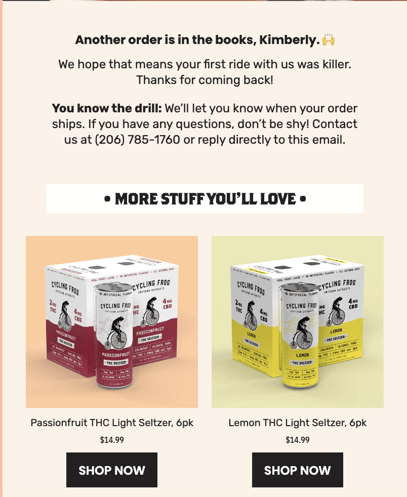
Timely and Relevant Content
Customer retention emails serve various purposes. They keep customers informed, provide support, meet their needs, and re-engage them when they have been inactive. Send emails at strategic points along the customer journey, such as after a purchase or on anniversaries. Also, let customers know how often or at what times to expect your emails, and give them a chance to adjust the timing (e.g., to ask for a weekly digest instead of daily updates).
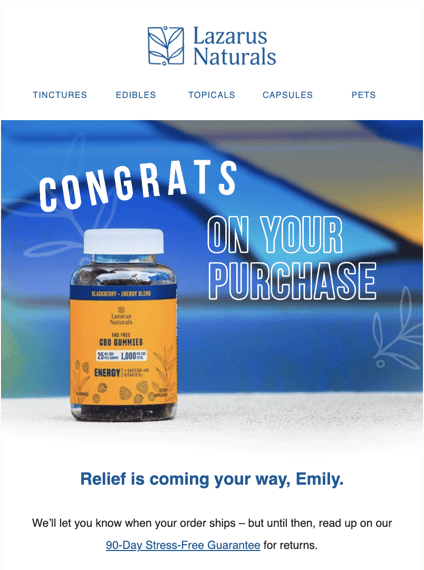
Your customer retention emails should also deliver relevant content, such as product recommendations or promotional offers, to encourage engagement. Providing relevant offers improves the chances of customers making repeat purchases.
Educational Content
Position your brand as an industry expert by sharing valuable insights and educational content. Helping customers get the maximum value from your products or services not only strengthens your brand image but also keeps customers engaged with your emails.
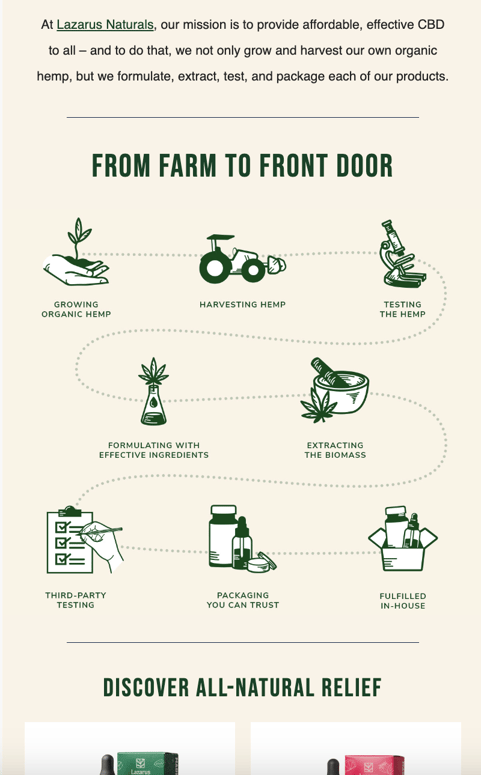
Clear Call to Action (CTA)
Just like every email you send, retention emails should have a clear and compelling call to action. A good CTA prompts people to do something, such as trying a new product, answering a survey, or benefiting from a special deal.
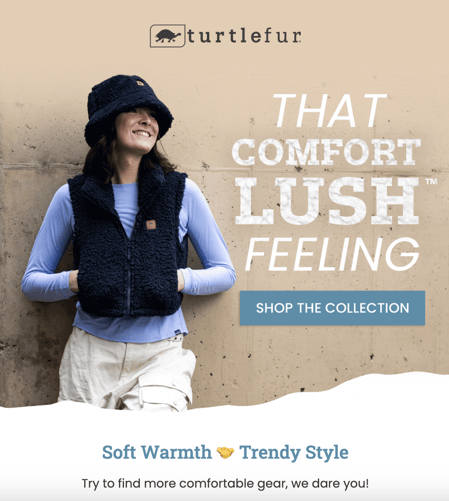
Engaging Subject Lines
Craft attention-grabbing subject lines that entice customers to open your emails. A catchy subject line sets the tone for the email and makes customers more likely to read it.
Examples of Effective Customer Retention Emails
Plenty of brands are finding success with customer retention emails. If you need some inspiration, here are three examples of specific strategies to get you started:
New Customer Email
Blazy Susan uses a new customer email flow to introduce the brand to first-time purchasers, build trust, and encourage engagement. This automated series of emails typically involves up to four emails that are sent to new customers over a set period.
The customer retention email below is the first email in the new customer series. It’s a welcome email designed to make customers feel good about their purchase by pulling them into the brand story and offering them an exclusive discount.

Repeat Customer
Cycling Frog employs a repeat customer flow to engage and retain customers who have already made a purchase. The goal of this automated series is to encourage repeat business by providing valuable content, personalized recommendations, and sales values that keep the brand top of mind.
The customer retention email below is the first email in the repeat customer series. It’s similar to the new customer email, but the message is adjusted to engage repeat customers with personalized recommendations and support information.

Customer Winback
BAD Workwear’s customer winback flow targets customers who have previously made a purchase but have not engaged with the brand recently. The goal of this flow is to win back these customers, encourage them to make another purchase, and ultimately increase their engagement with and loyalty to the brand.
The customer retention email below is the first email in the customer winback series. The purpose of this email is to win back the customer who hasn’t purchased in a while. BAD Workwear gives recipients a reason to get back on the website to see new inventory.
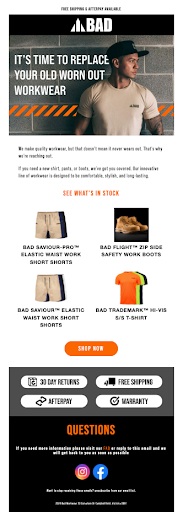
Attention to Retention
Customer retention emails are a powerful tool in a brand’s arsenal, contributing significantly to long-term success. By implementing best practices and consistently engaging with customers in a meaningful way, businesses can not only retain their customer base but also drive toward their overarching goals. Strong customer relationships through retention emails are crucial for success in a competitive market.
To learn more about effective revenue-driving automated emails and how they can positively impact your business, check out our Email Marketing Templates for E-Commerce: Revenue-Driving Email Flows e-book. It covers how to build your email marketing list, familiarize your audience with your brand, nurture relationships with your subscribers, and capture revenue through automated email flows.

About the author
Emily Bongiovanni is an E-Commerce Marketing Strategist at SmartBug. She has a passion for driving growth and delivering exceptional results with data-driven strategies. With over 8 years of experience in the dynamic world of marketing, she has a proven track record of helping businesses excel in the digital realm. When she's not strategizing or analyzing, you can find her walking her Australian Shepherd, hiking, or tackling a DIY project at home. Read more articles by Emily Bongiovanni.






